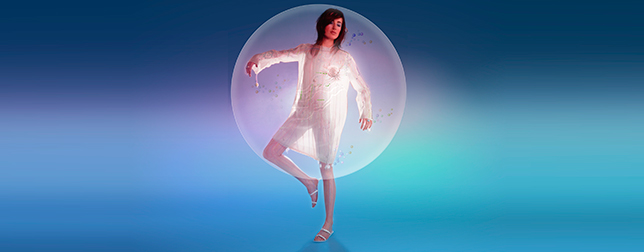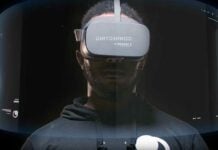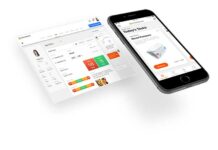Dr Jenny Tillotson is Senior Research Fellow at the School of Fashion & Textiles at Central Saint Martins, Visiting Scholar at the Institute of Biotechnology, University of Cambridge, and a Fellow of the Royal Society of the Arts. We had the chance to conduct a short interview with her on her smell-related projects.
1. What is your background and how long have you been involved in the Wearable Technologies field?
I obtained my PhD in Textiles from the Royal College of Art (1997) and a BA in Fashion from Central Saint Martins (1991). My research is inspired by science fiction and investigates the growing art and science of ‘Scentsory Design®’. This exists at the cross-over of emerging technologies, fashion and the science of smell, investigating how it affects the human brain and senses. I have been actively working in this field for 15 years during which time I have exhibited internationally, published in science and design journals, and won numerous awards including a nomination from the ‘FiFi’ Awards for breakthrough progress in the fragrance industry. In 2000 I worked for a MIT Media Lab spinout company in Wearable Computing (Charmed Technology Inc). I have also done consultancy work for NIKE and Unilever, collaborated with Philips and The North Face, and prior to my academic work I was a fashion stylist (TV, pop promos, editorial). I work closely with my husband, a menswear designer who worked with Thierry Mugler for 14 years (from 1979), and so this is where a lot of the sci-fi influences come from. I am marketing my research at the University of Cambridge and the University of Arts, London, and am very interested in the whole QS movement.
2. You are working on a project that combines smell technology and wearables. What is smell technology?
Scentsory Design® unites emerging technologies, complementary and alternative medicine, wellbeing and ’emotional fashion’ with the ancient art of perfumery and the therapeutic power of essential oils. Smell is a very difficult medium to work with, which explains why it is one of the last senses to feature in the wearable technology arena. There is increasing evidence in the growing field of ‘aromachology’ (i.e. the study between scent and psychology founded by the Sense of Smell Institute in 1989) that certain evidence-based essential oils can reduce stress by influencing mood, physiology and behaviour, emotional states and improve sleep. For example, citrus is known to alleviate stress and lavender can sedate, etc.
My projects build on the latest aromachology research and stem from science fiction by projecting strange new connections between different disciplines in science, art and pop culture. My work explores interactive fragrance technology (i.e. scent-on-demand) that goes beyond (passive) scratch and sniff, burning incense and (alcohol-based) perfume bottles to create a ‘Smart Second Skin’, a protective layer that comforts, heals and relaxes. Often compared with the military police in ‘Star Trek: The Next Generation’ who sniffed aromas from sensory emitters embedded in uniforms to change their state of mind, I am developing new ways to deliver scent from intelligent mood-enhancing clothing. By creating an ‘active’ scent symphony tailored to suit your mood throughout the day, I am developing a new wearable concept in electronic perfumery that stimulates the sense of smell to trigger emotion. In a similar light to the scent organ in Aldous Huxley’s ‘Brave New World’ novel, it works as an olfactory keyboard that stores your favourite wellness scents. The idea is that it has the ability to choose from an entire palette of scents changing over time, depending on how you are feeling. My ultimate goal is to embed electronic nose sensors into responsive clothes to diagnose cancer, or stress-related body odour. Learn more…
3. What kind of “scented” wearables have you developed so far? What is their purpose?
eScent®: A patented wearable wireless project developed in collaboration with Professor Andreas Manz (a pioneer of lab-on-a-chip). It is a user-worn delivery device, capable of dispensing sensory effects in response to a stimulus (i.e. timer, switch, biometric sensors). Initially it was designed for human wellbeing but can also be used as an insect repellent or for designer fragrances, and has the potential to replace less controlled technologies (i.e. traditional perfume bottle thereby reducing the need for solvents, which irritate the skin). Programmed and activated by the user alone, eScent® delivers a non-invasive ‘wardrobe of fragrances’, as a personalised, intimate and non-invasive scent bubble in a controllable manner, depending on mood or time of day. If combined with biometric sensors that measure how you are feeling, clothes and jewellery could enhance the mood by emitting soothing scents to reduce stress, boost energy and increase confidence.
Scent Whisper: A wearable wireless jewellery set worn by two people, inspired by Spiderman and the defence mechanisms in insects (e.g. bombardier beetles squirting predators and spiders spinning webs). An aromatic message is ‘scent by a wireless web’ from a spider broach with an embedded humidity sensor (that detects human breath) to a beetle broach which triggers the release of scent on demand. This is either a good scent or a bad scent depending on the context of the intended aromatic message (could be used for a lover, against an enemy, crowd control, etc.).
Lift My Mind: was a computer-controlled prototype designed for The North Face sports endurance running collection. It offers the selective delivery of multiple scents from a disposable ‘solid-scent’ cartridge system designed by CEROMA, a new spinout company from the University of Cambridge. Examples include evidence-based scents such as peppermint to increase speed, sports and mental performance, cognitive functioning and lavender to relax. It has the added advantage of using solid-scent which is inherently compatible with electronic equipment vs. liquid perfumes which cause leakage or cross contamination.
4. What is the ‘stress/sleep’ project that you have been working on for Philips?
This was a ‘Knowledge Transfer Fellowship’ called ‘Smell The Colour Of The Rainbow’ to improve on the design of the eScent® (see above), for the benefit of the fashion, health, fitness and the ecological consumer market, through collaboration with Philips. Over the course of 18 months, my team engaged in an active Knowledge Transfer programme to explore opportunities resulting from my patented work on ‘eScent®’ in areas of interest to Philips. The aim of the fellowship was to advance ways of improving the quality of care in the wider community; to reduce stress and improve sleep, using essential oils in wearable technologies and to demonstrate the effectiveness of prototypes that react to the physiological response of the wearer (e.g. to reflect mood). The identified application has primarily been within Philips Lighting for stress/sleep businesses (SAD/therapy/‘mood’ lamps) and ‘Philips AVENT’ (mother/child) which include concepts such as ‘InnoSCENT’, a wearable wireless baby monitor worn by the mother in close proximity to the baby.
Significant knowledge transfer took place during the fellowship benefiting Philips and my QS research on mood and sleep disorders. The findings focus on evidence-based essential oils as the basis for wearable product ideas using joint expertise in design, fragrance, colour therapy and technology. These elements were introduced into the world of health and wellbeing via the mood-enhancement route. Essential oils such as sweet orange and lavender were validated and correlated with colour to create a personalised ‘therapeutic rainbow’ pendulum, spanning de-stress/relief-calm/peaceful/relax-super-energize. Besides Philips, the fellowship impacted on the fragrance/wellbeing and fashion industries, mental health community and Complementary & Alternative Medicine.
5. At the University of Cambridge you are working on biosensing projects? What are these projects about and what are their goals?
At the Institute of Biotechnology where I work at the University of Cambridge, we are world leaders in biosensors, constructing sensors working on a range of optical, acoustic and electrochemical principles for a broad range of clinically relevant analytes. We have also developed and patented a novel system for producing scent on demand from cheap, mass producible cartridges for integration with home or mobile electronics (this technology was used in the bag for The North Face – see above). Our current aim is to integrate real time data from sensing systems with our scent-producing technology such that scents are produced on response – this could be to relieve stress, alert the user to changes in condition, or simply to create pleasant aromas in response to stimuli.
6. What is your favourite Wearable Technologies product?
I don’t really have one as it’s not out yet. I believe scent could be the killer app!! If I had to choose, it would be a mixture of the Jawbone plus controlled, non-invasive scent dispensing technologies, plus electronic nose sensing…. see image of concept for DiagNOSE which shows a dress detecting early stage breast cancer through electronic nose sensing that sniffs breath.
Would you like to to learn more about Jenny Tillotson’s projects? Please contact us at info(at)wearable-technologies.com.















